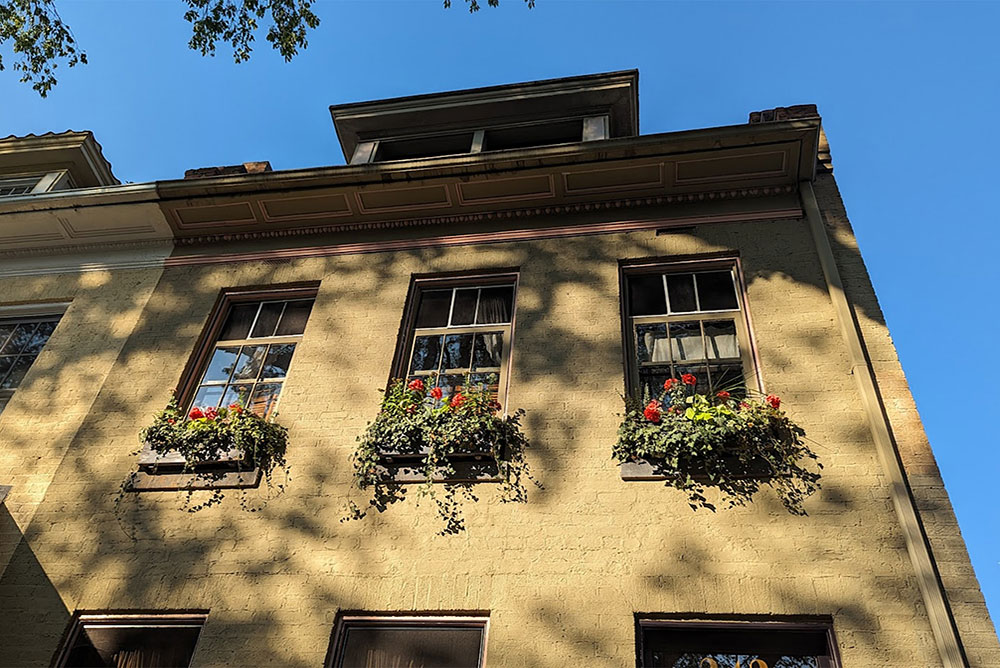
The Cavanaugh manse from below. Are the blooms live or are they Memorex? (And for those who are even older: Which twin has the Toni?) / Photo by Stephanie Cavanaugh.
By Stephanie Cavanaugh
IT’S TIME once again to discuss the judicious use of fake flowers in the garden, pots, and window boxes.
About now, you’ve thrown in the towel on seeing a blossom this season on the plumeria, the bird of paradise, or the hydrangea (bad pruning!). The peonies have developed a fuzzy rash and need to be lopped to the ground. Oh, that would be me, but you probably have a few sad-looking, or dead, plants.
Maybe you went on vacation, bad you, and the gorgeous, lush, enchanting garden you left just a week or so ago gagged in thirst and collapsed in a sad tangle.
Or, a raccoon demolished the herbs, your toddler made you a “bouquet,” or the next-door hound lifted his leg one too many times on the zinnias.
These are not disasters! They’re opportunities to visit a Michaels or other craft store, or let your fingers do the walking around Amazon, and gather a clutch of absolutely indestructible artificial flowers and greens that owe their good looks and unnatural health to substances unknown in nature.
I revisit this subject every year because every year there’s another issue. Early on, there were the lilies—there was a little sun in the garden back then. The lilies would come up all pink and splendid and then the flowers would expire and I had a clump of green sticks to look at for the rest of the summer.
Why I was moved to try wiring on some fakes is lost in the mists of time, but damn they looked good. So good that, most of the time, I even forgot they weren’t real. I’d remember only when a guest gasped in admiration at my brilliance: They’re growing so far past the season. HOW do you do it?!
Now, artificial flowers can be tacky. But there are ways to make them seem amusing, or très drôle. Saying anything in French provides an air of elegance, n’est-ce pas? Practice saying it while waving a bejeweled cigarette holder, cigarette not necessary.
You want subtle. The flowers and greenery should look as natural as possible: no oddball colors or unnatural-looking leaves (strip these off!!). And keep the fakes to 10% or less of any border, planter, or box. When you weave those fine mystery-substance stems into a living arrangement the eye just assumes they’re real.
For instance, my white Bird of Paradise (which is white in name only, since it refuses to flower) now has two flowers on a plant that bends under the porch ceiling (this variety grows to 30 feet, an event I did not anticipate when buying). These are not the fabulous birds one see in the tropics, with their strong beaks and colorful plumage; they’re kind of thin and wimpy. One’s kind of pinkish, the other is orange. But! They look real because . . . really, who would choose fakes like these?
(Baby found them somewhere for free and gifted them to me.)
My three second-floor window boxes are another story. Because they’re so high up, there’s no way of telling what’s fake and what isn’t. Multiple misfortunes decimated my accent plants this year, leaving me with (real) spikes in the center, sweet-potato vine in the front, and ivy on the edges. And two big gaps in each box.
I planted the most deliciously salmon-colored fake-silk—NOT PLASTIC—geraniums, a Michaels find, in the gaps. Looking up at them, you’d never know it. These will last for years. Just make sure you remove them after Thanksgiving, when geraniums would normally not be in bloom.
If you love geraniums, as I do, you’ve possibly, probably, had issues with them midsummer. They don’t much like baking heat and won’t do much if any flowering, though the foliage will be fine. If you have them at eye level and want to goose them a bit, get a bunch of fakes, strip off the foliage (that’s always a giveaway), cut them apart, and poke just a few flowers amid the greenery. Stop. That’s quite enough.
You can do this with other flowers as well: Just remember the 10% rule and keep them as natural-looking as possible.
Meanwhile, my two lower window boxes have mostly done well—except for something I put in (I forget what now) that didn’t make it, leaving a patch of dirt doing nothing. For this I have a collection of faux greens, plastic in fact, though of a non-shiny variety and a subdued shade, that work well as a filler—and could also be used in tricky little naked garden spaces.
You might call them garden toupées.
